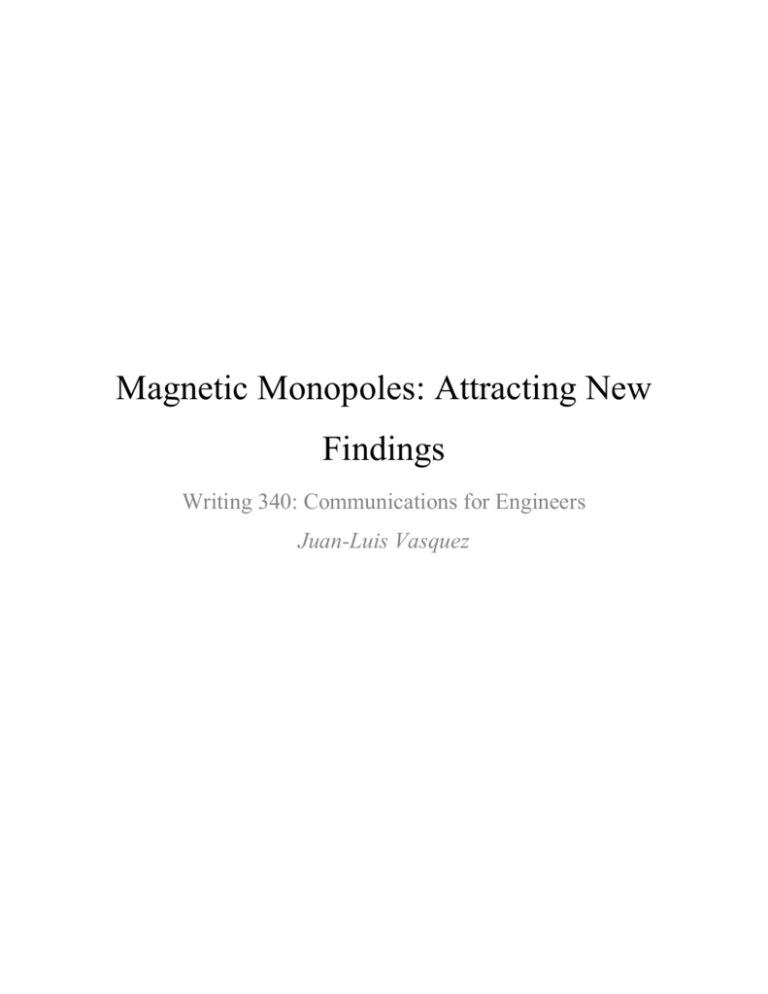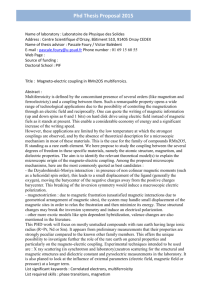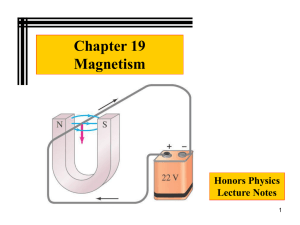
Magnetic Monopoles: Attracting New
Findings
Writing 340: Communications for Engineers
Juan-Luis Vasquez
Abstract
Magnetism is one of physics’ most applied fields contributing to countless crucial
devices throughout history. Discovered thousands of years ago and studied initially in the
11th century, the concept of magnetism has recently required augmentation due to a
discovery that was considered improbable. An experiment by David Hall and his
laboratory at Amherst College have successfully created and observed a magnetic
monopole in a controlled environment. This experiment represents a breakthrough in
electromagnetic physics proving a theory established in the 1930’s by Paul Dirac.
Introduction
Loudspeakers, motors, computers, elevators and cell phones all have something in
common: magnetism is a key element of their composition. Perhaps one of the least
noticed building blocks for a large portion of everyday appliances and devices,
magnetism is a crucial constituent for many apparatus. Since the observation of objects’
attraction to each other thousands of years ago in Magnesia, magnetism has since been a
fundamental part of human development and technology [3]. From navigational
instruments to breathtaking technology, the concept and application of magnetism
continues to be an important aspect of our lives. A recent discovery has extended our
understanding of magnetism where a single magnetic monopole was created and
observed. The experiment translated physicist Paul Dirac’s theory of magnetic
monopoles from the early 20th century into an observable phenomenon.
Magnets and Monopoles
Magnetic fields, such as that of our planet, are created from the interactions of
magnetic poles, which are “always seen in pairs” [1]. They have been experimentally
confirmed and observed to unquestionably consist of two interdependent poles until a
recent experiment proved otherwise. A bar magnet, for example, consists of a north pole
and a south pole where magnetic field lines originate in the north
pole of the magnet and into the south pole as observed in Figure 1. If
the magnet is cut in two, each half will still be constituted of two
poles and this effect carries down to the atomic level where
individual atoms “act like tiny magnets” [1]. Magnetism is not
caused by the interaction of two independent magnetic poles but
rather by “moving electric charges,” which was also the
Hyperphysics.phy-astr.gsu.edu
Figure 1: Magnetic field of a bar
magnet 1
technique used in the recent discovery of magnetic monopoles [2]. The isolation of a pole
had been illogical and unimaginable because, as proved in Maxwell’s equation, isolated
electric charges exist but “isolated magnetic charges do not” [1]. When quantum
mechanics changed the classical Newtonian approach of physics in the twentieth century,
physicist Paul Dirac theorized that magnetic monopoles could exist. Since Dirac’s theory
on the development of monopoles in 1931, countless experiments have been unsuccessful
to prove their existence. However, a recent discovery has proved what Dirac theorized
nearly a century ago: an isolated pole is achievable.
The theory and the experiment
Dirac theorized the possibility of a magnetic pole, a north or a south, also called a
magnetic monopole, independent of another. His theory combined classical
electromagnetism with the new perception provided by quantum mechanics to explain
and theorize the existence of magnetic monopoles. Quantum mechanics “deals mainly
with the microscopic world of atoms” as well as the world of extremely low temperatures
[4]. This aided Dirac in his theory of monopoles since several concepts from classical
electromagnetism were expressed and understood differently through quantum
mechanics.
Dirac’s theory of magnetic monopoles relied on the complex phase of a particle’s
wave function. A wave function, a function of space and time, describes a particle’s
evolution over time and is understood in complex numbers. Complex numbers are
expressed in real and imaginary units and are
abstract quantities used in complex domains such
as quantum mechanics. Dirac considered the
phase “properties of a wave function pierced by a
semi-infinite nodal line,” which in the experiment
was performed by an atom piercing the wave
function. This is illustrated in Figure 2 animated
as the spiraled line on the upper part of the
Heikka Valja
monopole. He noticed that the electromagnetic
Figure 2: Illustration of a magnetic monopole.
properties generate the “magnetic field of a
monopole” [5].
David Hall of Amherst College led the research that arrived at the creation and
observation of a magnetic monopole on January 30th, 2014. The method used by David
Hall’s to arrive at a monopole and to prove Dirac’s theory is what’s known as a Bose-
Einstein condensate. A Bose-Einstein condensate represents the lowest quantum state
attainable, where, in a controlled environment, a group of particles behave as a single
wave rather than individual particles. Hall’s group created this environment by cooling
rubidium atoms to “less than 100-billionths of a degree warmer than absolute zero” [6].
They then applied an external magnetic field to the condensate, also known as an electron
cloud, to “orient the constituent atoms” [1]. A rubidium atom then penetrated the wave
function “creating a hole in the center” and therefore yielding a magnetic monopole [6].
Applications of Monopoles
This recent breakthrough discovery opens up an immensely large range of
applications. Magnetic monopoles could be used in a wide range of fields due to their
rather unusual properties. For instance, magnetic monopoles create “electric fields when
moving,” in a similar manner that moving electric charges create magnetic fields [7].
This can be applied in certain electrical motors due to the magnetic and electrical
properties of a monopole. Another interesting application is when a magnetic monopole
nears a “current-carrying wire,” the monopole will orbit the wire creating electromagnetic
interactions [7]. This also seems promising considering the simplicity and effectiveness
such interaction could bring. The possibilities and applications are endless considering
the innumerable uses of magnetic fields and phenomena in our societies. An
unquestionable obstacle that will prove incorporating magnetic monopoles a challenging
task is their recreation in less extreme and unusual conditions. The applications of
magnetic monopoles in Bose-Einstein condensate are extremely limited and present a
new challenge on this subject matter: creating and observing magnetic monopoles in a
manageable and applicable scenario. This might seem impossible considering it took
extreme conditions to produce a monopole, but that goal also seemed unachievable not
too long ago.
New Course of Physics
The creation of magnetic monopoles in a controlled environment after initially
theorized eight decades prior is a monumental achievement in physics and science. This
discovery changes physicists’ perception of electromagnetism when considering quantum
mechanic conditions the way general relativity forced a new understanding of Newtonian
Mechanics. Despite being theoretically proved almost a century ago, the observation and
creation of magnetic monopoles is one that forces reevaluation of certain concepts in the
physics discipline. Textbooks will require certain adjustments and physics curricula in the
magnetism field will need revising. This discovery, similar to neutrinos being observed
for the first time last year, proves that physics is still unfolding with countless theories to
be proved.
Conclusion
Magnetism, being such an important and developed field in physics, continues to
prove how much we have to learn and discover, develop and understand, theorize and
experiment with this new achievement. The concept is far beyond our complete
understanding and the observation of an eighty-year-old theory on a very important
branch of magnetism leaves the physics community in amazement. Finding applications
of magnetic monopoles from the recent discovery poses a new challenge for scientists,
but one that can be extremely promising. The physics community is and will continue to
be heavily impacted by this discovery as many had discarded the theory’s potential proof.
Author bio
In spring of 2014, Juan-Luis Vasquez was in his second semester at USC. After
transferring from the University of San Francisco where he studied physics, he was an
electrical engineering student in his fourth year.
Contact Information
Juan-Luis Vasquez
Juanluiv@usc.edu
Keywords
Magnet, Magnetic, Monopole, Magnetism, Dirac.
Bibliography
[1] Edwin Cartlidge. (2014, Jan. 30). Magnetic Monopoles Seen in the Lab. [Online].
Available: http://physicsworld.com
[2] David J. Griffiths. “Magnetic Fields in Matter” in Introduction to
Electrodynamics, 4th ed. Glenview, IL: Pearson Prentice-Hall, 2013, pp. 269.
[3] Douglas C. Giancoli. “Magnetism” in Physics for Scientists and Engineers, 4th ed.
Upper Saddle River, NJ: Pearson Prentice-Hall, 2009, pp. 707.
[4] Douglas C. Giancoli. “Quantum Mechanics” in Physics for Scientists and
Engineers, 4th ed. Upper Saddle River, NJ: Pearson Prentice-Hall, 2009, pp. 1018.
[5] D.S. Hall et al. (2014, Jan. 30). Observation of Dirac Monopoles in a Synthetic
Magnetic Field. [Online]. Available: http://www.readcube.com/
[6] Lisa Winter. (2014). Synthetic Magnetic Monopoles have been created in the lab.
[Online]. Avaialable: http://www.iflscience.com
[7] Anders Sandberg. Magnetic Monopoles: Their Construction and Use. [Online].
Available: http://cybermax.tripod.com/Monopol.htm










